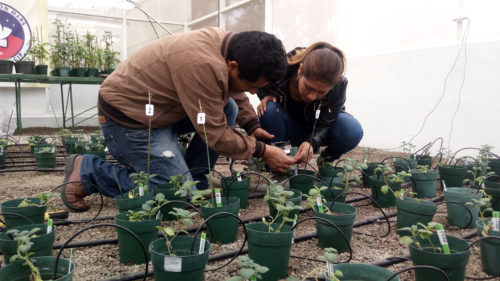
An experiment conducted by researchers at the International Potato Center (CIP) to determine whether potatoes could be grown on Mars not only produced encouraging results for proposals to put people on the Red Planet, it also provided valuable information for CIP’s efforts to help farmers produce food on this planet’s marginal lands.
The National Aeronautics and Space Administration (NASA) has set a goal of sending people to Mars by 2030, whereas the possibility of establishing a long-term human presence on the Red Planet has led scientists to investigate the feasibility of growing food there. CIP researchers undertook an experiment in 2016 to see if potato could be grown in the harsh soil of Pampas de la Joya – a hyper-arid section of Peru’s coastal desert – that is considered the closest thing to Martian soil available on Earth. The results of that experiment, recently published in the on-line version of the International Journal of Astrobiology, are encouraging for both astrobiologists and scientists who are tapping the potato’s potential for feeding people on an increasingly hot and crowded Earth.
David Ramirez, a crop ecophysiologist at CIP and the lead author of the article, explains that he and his colleagues placed in-vitro plantlets of 65 different potato genotypes inside peat pellets, watered them for two weeks, and then transplanted them into pots filled with soil from la Joya, as well as pots filled with peat soil as a control. Those plantlets included five improved varieties, 22 native potato varieties and 38 advanced clones from CIP’s lowland tropics virus resistant (LTVR) breeding population. Ramirez and colleagues report that 40 percent of those genotypes managed to grow in the la Joya soil and some of them produced small tubers, indicating a potential for producing potatoes in the dusty soil of Mars. However, Ramirez notes that potatoes would need to be grown inside an enclosure with controlled atmospheric pressure and temperature to survive on Mars – areas that require further research.
“With this study, we have the basis for contributing to the so-called ‘Bioregenerative Food System’ proposed by space agencies, based on a space agriculture using local resources – such as soil – in future missions to Mars,” Ramirez says.
He explains that the Martian-like la Joya soil has “the highest salinity conditions reported in scientific studies of potato,” and that future research in this area could include testing methodologies for reducing soil salinity using nanotechnology, or the use of microorganisms for degrading organic matter, which could potentially be recycled from the waste produced by the crew of a Mars expedition. Ramirez notes that the experiment’s results are also applicable to agriculture on Earth, where soil salinity threatens the productivity of farmland in many regions.
“It is extremely important to evaluate plants under such adverse conditions,” notes Ramirez. “Soil salinity is a problem that is becoming more intense in areas of the world where CIP works. This type of research helps us to learn how potato plants will respond to future conditions, and more importantly, how we can help farmers deal with those conditions.”

According to CIP potato breeder Walter Amoros, a co-author of the article, the two potatoes that produced the largest tubers in the la Joya soil are products of CIP’s LTVR breeding population, which CIP breeders are improving to produce new virus-resistant, early-maturing potato varieties that tolerate drought, heat and soil salinity. He explains that CIP researchers are now crossing those two genotypes with parents in the LTVR breeding population to improve the salt tolerance of future varieties.
“The experiment is helping us to generate new potato hybrids and breeding populations appropriate for areas such as Bangladesh and Central Asian countries that need potatoes that can tolerate this kind of stress,” says Amoros.
Amoros explains that the potato with the second best yield in the Mars experiment was released as a new variety in Bangladesh in 2016 and is now being grown in coastal areas that suffer saltwater intrusion – a problem that is expected to affect more farmland as climate change causes sea level to rise. It was one of various LTVR clones that CIP sent to the Bangladesh Agricultural Research Institute (BARI), which continues to evaluate others in Southern Bangladesh. Soil salinity is also a problem in dry areas where farmland is irrigated for many years, such as the Aral Sea Basin of Central Asia, where CIP is working with local partners to evaluate and release new potato varieties.
“Countries around the world have areas with desert-like conditions, and in the future they will want to consider growing potatoes in them,” observes Amoros. “What makes me happy isn’t so much that these potatoes could one day be grown on Mars, but that this experiment has helped us to identify potatoes that can help farmers produce potatoes in areas of this planet where it currently isn’t feasible.”
Link to the article in International Journal of Astrobiology:
